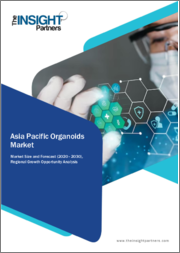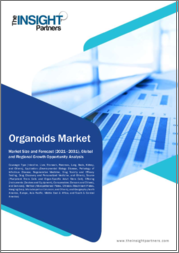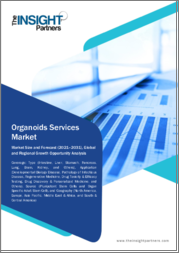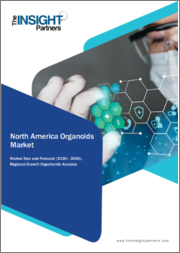
|
시장보고서
상품코드
1402760
아시아태평양의 오가노이드 시장 예측(-2030년) : 지역별 분석 - 장기 유형별, 용도별, 공급원별, 유형별Asia Pacific Organoids Market Forecast to 2030 - Regional Analysis - by Organ Type, Application, Source, and Type |
||||||
아시아태평양의 오가노이드 시장은 2022년 3억 4,124만 달러에서 2030년 18억 6,632만 달러로 성장할 것으로 예상되며, 2022년부터 2030년까지 연평균 23.7%의 성장률을 기록할 것으로 예상됩니다.
아시아태평양의 오가노이드 시장 활성화를 위한 신약개발 활동
신약 및 첨단 의약품에 대한 수요가 증가하면서 전체 신약 개발 및 연구 속도가 빨라지고 있으며, ClinicalTrials.gov에 따르면 2020년에는 총 356,282건의 임상시험이 진행될 것으로 예상됩니다. 혜택을 받을 가능성이 낮은 환자들을 식별함으로써 고가의 약물의 비용 효율성을 높일 수 있다고 합니다. 세계 임상시험의 증가는 오가노이드 모델을 포함한 첨단 의료 기술에 대한 수요를 촉진할 것으로 예상됩니다.
또한, 신약개발에서 오가노이드는 암뿐만 아니라 낭포성섬유증, 다낭성 신질환, 소두증, 장 및 호흡기 감염 등 다른 질환에도 사용되고 있습니다. 예를 들어, 오가노이드는 장기의 구조와 기능 등 장기의 특성을 요약할 수 있습니다. 또한 오가노이드는 조직과 장기의 원래 유전적, 에피제네틱스적 상태를 복원할 수 있기 때문에 유전자 편집에 적합합니다. 여러 연구에서 CRISPR-Cas9 기술과 오가노이드의 조합으로 좋은 결과를 보여줌으로써 낭포성섬유증에 대한 돌파구 마련의 기회를 넓히고 있습니다. 2020년 발표된 연구 "CRISPR-Based Adenine Editors Correct Nonsense Mutation in a Cystic Fibrosis Organoid Biobank"에 따르면, 낭포성섬유증 장내 장기 장기 바이오뱅크는 664명의 환자를 대표하며, 그 중 -20%는 아데닌 편집기를 통해 낭포성섬유증 막 관통형 전도체 수용체의 넌센스 돌연변이를 이론적으로 효율적으로 복구할 수 있었습니다. 일부 동물 모델에서 유전자 편집 오가노이드의 성과가 있지만, 그 효율이 현저하게 낮고 성공률이 높지 않습니다. 따라서 유전자 편집 오가노이드의 안전성, 장기 안정성 및 기능성을 위한 공정 연구 개발은 매우 중요합니다.
또한, COVID-19의 팬데믹으로 인해 인간 폐 오가노이드 모델을 개발해야 할 필요성이 대두되었습니다. 예를 들어, Millipore Sigma는 3dGRO 인간 폐 오가노이드 배양 시스템을 개발했습니다. 이 시스템은 연구자들이 인간 폐 상피의 오가노이드 모델을 배양하기 위해 장기 조직을 제어, 접근 및 재현하여 연구 중에 긍정적이고 성공적인 결과를 얻을 수 있도록 도와줍니다. 따라서 이러한 기술 혁신은 시장 성장에 더 큰 성장 기회를 제공 할 것으로 예상됩니다.
아시아태평양의 오가노이드 시장 개요
아시아태평양의 오가노이드 시장은 호주, 중국, 인도, 일본, 한국, 기타 아시아태평양으로 구분됩니다. 이 지역의 시장은 암 발병률 증가, 유전자 돌연변이 및 암 연구에 대한 수요 증가, 인간 오가노이드 관련 인식을 높이기 위한 정부의 노력, 첨단 인간 오가노이드 제품의 연구 개발 및 상용화를 위한 지원 규제, 오가노이드 연구에 대한 자금 지원 증가 등의 요인으로 인해 성장세를 보이고 있다, 예측 기간 동안 가장 빠른 속도로 성장할 것으로 보입니다.
아시아태평양의 오가노이드 시장 매출 및 2030년까지의 예측(금액)
아시아태평양 오가노이드 시장 세분화
아시아태평양의 오가노이드 시장은 장기 유형, 용도, 공급원, 국가별로 분류됩니다.
장기 유형에 따라 아시아태평양의 오가노이드 시장은 장, 간, 위, 췌장, 폐, 뇌, 신장 및 기타로 분류되며, 2022년 아시아태평양의 오가노이드 시장에서 장 부문이 가장 큰 점유율을 차지했습니다.
유형별로는 아시아태평양 오가노이드 시장은 장비, 소모품, 서비스로 구분됩니다. 소모품 부문은 2022년 아시아태평양 오가노이드 시장에서 가장 큰 점유율을 차지했습니다.
용도별로는 발생생물학, 감염성 질환 병태생리, 재생의료, 약물 독성 및 유효성 시험, 신약개발 및 맞춤의료, 기타로 구분되며, 발생생물학 부문이 2022년 아시아태평양 오가노이드 시장에서 가장 큰 비중을 차지했습니다.
공급원에 따라 아시아태평양의 오가노이드 시장은 만능줄기세포와 장기특이적 성체줄기세포로 구분되며, 2022년 아시아태평양 오가노이드 시장에서 만능줄기세포 분야가 큰 점유율을 차지했습니다.
국가별로 보면 아시아태평양의 오가노이드 시장은 일본, 중국, 호주, 인도, 한국 및 기타 아시아태평양으로 구분되며, 2022년 아시아태평양의 오가노이드 시장은 일본이 독점했습니다.
목차
제1장 서론
제2장 주요 요약
- 아시아태평양의 주요 인사이트
- 아시아태평양 시장 매력
제3장 조사 방법
- 조사 범위
- 2차 조사
- 1차 조사
제4장 아시아태평양의 오가노이드 시장 상황
- 개요
- 아시아태평양의 PEST 분석
제5장 아시아태평양의 오가노이드 시장 : 주요 산업 역학
- 주요 시장 성장 촉진요인
- 종양 모델링과 바이오뱅크 수요 증가
- 개별화 의약품 채용 확대
- 동물 실험 모델 대체품 개발에 대한 주목 상승
- 주요 시장 성장 억제요인
- 기존 워크플로우로의 오가노이드 결합에 관한 문제
- 숙련된 전문가의 부족
- 주요 시장 기회
- Drug Discovery 활동 중시
- 향후 동향
- 오가노이드와 Organ-On-A-Chip 조합
- 영향 분석
제6장 오가노이드 시장 : 아시아태평양의 시장 분석
- 아시아태평양의 오가노이드 시장 매출, 2022-2030년
제7장 아시아태평양의 오가노이드 시장 - 2030년까지 매출과 예측 : 장기 유형별
- 아시아태평양의 오가노이드 시장 매출 점유율 : 장기 유형별, 2022년·2030년(%)
- 위
- 장
- 간
- 췌장
- 폐
- 뇌
- 신장
- 기타
제8장 아시아태평양의 오가노이드 시장 - 2030년까지 매출과 예측 : 용도별
- 아시아태평양의 오가노이드 시장 매출 점유율 : 용도별, 2022년·2030년(%)
- 발생생물학
- 감염증 질환 병상
- 재생의료
- 약물 독성·유효성 시험
- Drug Discovery·맞춤형 의료
- 기타
제9장 아시아태평양의 오가노이드 시장 - 2030년까지 매출과 예측 : 공급원별
- 아시아태평양의 오가노이드 시장 매출 점유율 : 공급원별, 2022년·2030년(%)
- 만능줄기세포
- 장기 특이적 성체줄기세포
제10장 아시아태평양의 오가노이드 시장 - 2030년까지 매출과 예측 : 유형별
- 아시아태평양의 오가노이드 시장 매출 점유율 : 유형별, 2022년·2030년(%)
- 기기
- 소모품
- 서비스
제11장 아시아태평양의 오가노이드 시장 : 국가별 분석
제12장 COVID-19 전후의 영향
- COVID-19 전후의 영향
제13장 아시아태평양의 오가노이드 시장 : 업계 상황
- 시장 진출 기업 성장 전략(%)
- 유기적 발전
- 무기적 발전
제14장 아시아태평양의 오가노이드 시장 : 주요 기업 개요
- STEMCELL Technologies Inc.
- Cellesce Ltd
- Thermo Fisher Scientific Inc
- Corning Inc
- Merck KGaA
- InSphero
제15장 부록
ksm 24.01.15The Asia Pacific organoids market is expected to grow from US$ 341.24 million in 2022 to US$ 1,866.32 million by 2030. It is estimated to grow at a CAGR of 23.7% from 2022 to 2030.
Focus on Drug Discovery Activities Fuel the Asia Pacific Organoids Market
The increasing demand for new and advanced drugs is driving the overall pace of drug discovery and research. According to ClinicalTrials.gov, the total number of clinical trial studies in 2020 was estimated to be 356,282. A recent survey by the Hubrecht Institute states that organoids can potentially make expensive drugs more cost-effective by identifying patients who are not likely to benefit from the drug. An increasing number of clinical trials worldwide is expected to drive the demand for advanced medical technologies, including organoid models.
Further, organoids in drug discovery are not limited to just cancer, they are also used in other diseases, such as cystic fibrosis, polycystic kidney disease, microcephaly, and infectious diseases of the gut and airway. For instance, organoids can summarize the properties of an organ, such as organ structure and function. Also, organoids can restore a tissue or organ's original genetic and epigenetic state, making them suitable for gene editing. Various studies have shown positive results of combining CRISPR-Cas9 technology with organoids, which has expanded opportunities for breakthroughs in cystic fibrosis. According to a study 'CRISPR-Based Adenine Editors Correct Nonsense Mutations in a Cystic Fibrosis Organoid Biobank,' published in 2020, a biobank of cystic fibrosis intestinal organoids represented 664 patients, and ~20% of them were theoretically able to efficiently repair nonsense mutations in the cystic fibrosis transmembrane conductor receptor through adenine base editors. Despite a few achievements of gene-edited organoids in some animal models, their efficiency is significantly low, and the success rate is not high. Therefore, it is crucial to research and develop a process for gene-edited organoids' safety, long-term stability, and functionality.
Moreover, the COVID-19 pandemic triggered the need to develop human lung organoid models. For instance, MilliporeSigma developed a 3dGRO Human Lung Organoid Culture System that allows researchers to control, access, and reproduce organ tissue for culturing an organoid model of human lung epithelium that can aid in obtaining positive and successful results during their research. Thus, such innovations are expected to offer more significant growth opportunities for the market growth.
Asia Pacific Organoids Market Overview
The Asia Pacific organoids market is segmented into Australia, China, India, Japan, South Korea, and the Rest of Asia Pacific. The market in the region is likely to continue to grow at the fastest rate during the forecast period owing to factors such as increasing incidences of cancer, growing demand for gene mutation and cancer research, government efforts to raise awareness related to human organoids, supportive regulations for the development and commercialization of advanced human organoids products, and increased funding for organoids research.
Asia Pacific Organoids Market Revenue and Forecast to 2030 (US$ Million)
Asia Pacific Organoids Market Segmentation
The Asia Pacific organoids market is segmented into organ type, type application, source, and country.
Based on organ type, the Asia Pacific organoids market is segmented into intestine, liver, stomach, pancreas, lung, brain, kidney, and others. The intestine segment held the largest share of the Asia Pacific organoids market in 2022.
Based on type, the Asia Pacific organoids market is segmented into instruments, consumables, and services. The consumables segment held the largest share of the Asia Pacific organoids market in 2022.
Based on application, the Asia Pacific organoids market is segmented into developmental biology disease, pathology of infectious disease, regenerative medicine, drug toxicity and efficacy testing, drug discovery and personalized medicine, and others. The developmental biology disease segment held largest share of the Asia Pacific organoids market in 2022.
Based on source, the Asia Pacific organoids market is bifurcated into pluripotent stem cells and organ-specific adult stem cell. The pluripotent stem cells segment held a larger share of the Asia Pacific organoids market in 2022.
Based on country, the Asia Pacific organoids market is segmented into the Japan, China, Australia, India, South Korea, and the Rest of Asia Pacific. Japan dominated the Asia Pacific organoids market in 2022.
Cellesce, Corning Inc, InSphero, Merck KGaA, STEMCELL Technologies Inc, and Thermo Fisher Scientific Inc are some of the leading companies operating in the Asia Pacific organoids market.
Reasons to Buy:
- Save and reduce time carrying out entry-level research by identifying the growth, size, leading players, and segments in the Asia Pacific organoids market.
- Highlights key business priorities in order to assist companies to realign their business strategies.
- The key findings and recommendations highlight crucial progressive industry trends in Asia Pacific organoids market, thereby allowing players across the value chain to develop effective long-term strategies.
- Develop/modify business expansion plans by using substantial growth offering developed and emerging markets.
- Scrutinize in-depth Asia Pacific market trends and outlook coupled with the factors driving the market, as well as those hindering it.
- Enhance the decision-making process by understanding the strategies that underpin security interest with respect to client products, segmentation, pricing and distribution.
Table Of Contents
1. Introduction
- 1.1 The Insight Partners Research Report Guidance
- 1.2 Market Segmentation
2. Executive Summary
- 2.1 Asia Pacific Key Insights
- 2.2 Asia Pacific Market Attractiveness
3. Research Methodology
- 3.1 Coverage
- 3.2 Secondary Research
- 3.3 Primary Research
4. Asia Pacific Organoids Market Landscape
- 4.1 Overview
- 4.2 Asia Pacific PEST Analysis
5. Asia Pacific Organoids Market - Key Industry Dynamics
- 5.1 Key Market Drivers:
- 5.1.1 Increasing Demand for Tumor Modeling and Biobanking
- 5.1.2 Growing Adoption of Personalized Drugs
- 5.1.3 Rising Focus on Developing Alternatives for Animal Testing Models
- 5.2 Key Market Restraints:
- 5.2.1 Issues Related to Incorporation of Organoids into Existing Workflows
- 5.2.2 Dearth of Skilled Professionals
- 5.3 Key Market Opportunities:
- 5.3.1 Focus on Drug Discovery Activities
- 5.4 Future Trends:
- 5.4.1 Combining Organoid with Organ-On-A-Chip
- 5.5 Impact Analysis:
6. Organoids Market - Asia Pacific Market Analysis
- 6.1 Asia Pacific Organoids Market Revenue (US$ Mn), 2022 - 2030
7. Asia Pacific Organoids Market - Revenue and Forecast to 2030 - by Type
- 7.1 Overview
- 7.2 Asia Pacific Organoids Market Revenue Share, by Organ Type 2022 & 2030 (%)
- 7.3 Stomach
- 7.3.1 Overview
- 7.3.2 Stomach: Asia Pacific Organoids Market - Revenue and Forecast to 2030 (US$ Million)
- 7.4 Intestine
- 7.4.1 Overview
- 7.4.2 Intestine: Asia Pacific Organoids Market - Revenue and Forecast to 2030 (US$ Million)
- 7.5 Liver
- 7.5.1 Overview
- 7.5.2 Liver: Asia Pacific Organoids Market - Revenue and Forecast to 2030 (US$ Million)
- 7.6 Pancreas
- 7.6.1 Overview
- 7.6.2 Pancreas: Asia Pacific Organoids Market - Revenue and Forecast to 2030 (US$ Million)
- 7.7 Lung
- 7.7.1 Overview
- 7.7.2 Lung: Asia Pacific Organoids Market - Revenue and Forecast to 2030 (US$ Million)
- 7.8 Brain
- 7.8.1 Overview
- 7.8.2 Brain: Asia Pacific Organoids Market - Revenue and Forecast to 2030 (US$ Million)
- 7.9 Kidney
- 7.9.1 Overview
- 7.9.2 Kidney: Asia Pacific Organoids Market - Revenue and Forecast to 2030 (US$ Million)
- 7.10 Others
- 7.10.1 Overview
- 7.10.2 Others: Asia Pacific Organoids Market - Revenue and Forecast to 2030 (US$ Million)
8. Asia Pacific Organoids Market - Revenue and Forecast to 2030 - by Application
- 8.1 Overview
- 8.2 Asia Pacific Organoids Market Revenue Share, by Application 2022 & 2030 (%)
- 8.3 Developmental Biology
- 8.3.1 Overview
- 8.3.2 Developmental Biology: Asia Pacific Organoids Market - Revenue and Forecast to 2030 (US$ Million)
- 8.4 Disease Pathology of Infectious Disease
- 8.4.1 Overview
- 8.4.2 Disease Pathology of Infectious Disease: Asia Pacific Organoids Market - Revenue and Forecast to 2030 (US$ Million)
- 8.5 Regenerative Medicine
- 8.5.1 Overview
- 8.5.2 Regenerative Medicine: Asia Pacific Organoids Market - Revenue and Forecast to 2030 (US$ Million)
- 8.6 Drug Toxicity and Efficacy Testing
- 8.6.1 Overview
- 8.6.2 Drug Toxicity and Efficacy Testing: Asia Pacific Organoids Market - Revenue and Forecast to 2030 (US$ Million)
- 8.7 Drug Discovery and Personalized Medicine
- 8.7.1 Overview
- 8.7.2 Drug Discovery and Personalized Medicine: Asia Pacific Organoids Market - Revenue and Forecast to 2030 (US$ Million)
- 8.8 Others
- 8.8.1 Overview
- 8.8.2 Others: Asia Pacific Organoids Market - Revenue and Forecast to 2030 (US$ Million)
9. Asia Pacific Organoids Market - Revenue and Forecast to 2030 - by Source
- 9.1 Overview
- 9.2 Asia Pacific Organoids Market Revenue Share, by Source 2022 & 2030 (%)
- 9.3 Pluripotent Stem Cells
- 9.3.1 Overview
- 9.3.2 Pluripotent Stem Cells: Asia Pacific Organoids Market - Revenue and Forecast to 2030 (US$ Million)
- 9.4 Organ-specific Adult Stem Cells
- 9.4.1 Overview
- 9.4.2 Organ-specific Adult Stem Cells: Asia Pacific Organoids Market - Revenue and Forecast to 2030 (US$ Million)
10. Asia Pacific Organoids Market - Revenue and Forecast to 2030 - by Type
- 10.1 Overview
- 10.2 Asia Pacific Organoids Market Revenue Share, by Type 2022 & 2030 (%)
- 10.3 Instruments
- 10.3.1 Overview
- 10.3.2 Instruments: Asia Pacific Organoids Market - Revenue and Forecast to 2030 (US$ Million)
- 10.4 Consumables
- 10.4.1 Overview
- 10.4.2 Consumables: Asia Pacific Organoids Market - Revenue and Forecast to 2030 (US$ Million)
- 10.5 Services
- 10.5.1 Overview
- 10.5.2 Services: Asia Pacific Organoids Market - Revenue and Forecast to 2030 (US$ Million)
11. Asia Pacific Organoids Market - Country Analysis
- 11.1 Asia Pacific Organoids Market, Revenue and Forecast to 2030
- 11.1.1 Overview
- 11.1.2 Asia Pacific Organoids Market by Country
- 11.1.2.1 China
- 11.1.2.1.1 Overview
- 11.1.2.1.2 China Organoids Market Revenue and Forecast to 2030 (US$ Mn)
- 11.1.2.1.3 China Organoids Market, by Organ Type
- 11.1.2.1.4 China Organoids Market, by Application
- 11.1.2.1.5 China Organoids Market, by Source
- 11.1.2.1.6 China Organoids Market, by Type
- 11.1.2.2 Japan
- 11.1.2.2.1 Overview
- 11.1.2.2.2 Japan Organoids Market Revenue and Forecast to 2030 (US$ Mn)
- 11.1.2.2.3 Japan Organoids Market, by Organ Type
- 11.1.2.2.4 Japan Organoids Market, by Application
- 11.1.2.2.5 Japan Organoids Market, by Source
- 11.1.2.2.6 Japan Organoids Market, by Type
- 11.1.2.3 India
- 11.1.2.3.1 Overview
- 11.1.2.3.2 India Organoids Market Revenue and Forecast to 2030 (US$ Mn)
- 11.1.2.3.3 India Organoids Market, by Organ Type
- 11.1.2.3.4 India Organoids Market, by Application
- 11.1.2.3.5 India Organoids Market, by Source
- 11.1.2.3.6 India Organoids Market, by Type
- 11.1.2.4 Australia
- 11.1.2.4.1 Overview
- 11.1.2.4.2 Australia Organoids Market Revenue and Forecast to 2030 (US$ Mn)
- 11.1.2.4.3 Australia Organoids Market, by Organ Type
- 11.1.2.4.4 Australia Organoids Market, by Application
- 11.1.2.4.5 Australia Organoids Market, by Source
- 11.1.2.4.6 Australia Organoids Market, by Type
- 11.1.2.5 South Korea
- 11.1.2.5.1 Overview
- 11.1.2.5.2 South Korea Organoids Market Revenue and Forecast to 2030 (US$ Mn)
- 11.1.2.5.3 South Korea Organoids Market, by Organ Type
- 11.1.2.5.4 South Korea Organoids Market, by Application
- 11.1.2.5.5 South Korea Organoids Market, by Source
- 11.1.2.5.6 South Korea Organoids Market, by Type
- 11.1.2.6 Rest of Asia Pacific
- 11.1.2.6.1 Overview
- 11.1.2.6.2 Rest of Asia Pacific Organoids Market Revenue and Forecast to 2030 (US$ Mn)
- 11.1.2.6.3 Rest of Asia Pacific Organoids Market, by Organ Type
- 11.1.2.6.4 Rest of Asia Pacific Organoids Market, by Application
- 11.1.2.6.5 Rest of Asia Pacific Organoids Market, by Source
- 11.1.2.6.6 Rest of Asia Pacific Organoids Market, by Type
- 11.1.2.1 China
12. Pre & Post COVID-19 Impact
- 12.1 Pre & Post COVID-19 Impact
13. Asia Pacific Organoids Market Industry Landscape
- 13.1 Overview
- 13.2 Growth Strategies Done by the Companies in the Market, (%)
- 13.3 Organic Developments
- 13.3.1 Overview
- 13.4 Inorganic Developments
- 13.4.1 Overview
14. Asia Pacific Organoids Market, Key Company Profiles
- 14.1 STEMCELL Technologies Inc.
- 14.1.1 Key Facts
- 14.1.2 Business Description
- 14.1.3 Products and Services
- 14.1.4 Financial Overview
- 14.1.5 SWOT Analysis
- 14.1.6 Key Developments
- 14.2 Cellesce Ltd
- 14.2.1 Key Facts
- 14.2.2 Business Description
- 14.2.3 Products and Services
- 14.2.4 Financial Overview
- 14.2.5 SWOT Analysis
- 14.2.6 Key Developments
- 14.3 Thermo Fisher Scientific Inc
- 14.3.1 Key Facts
- 14.3.2 Business Description
- 14.3.3 Products and Services
- 14.3.4 Financial Overview
- 14.3.5 SWOT Analysis
- 14.3.6 Key Developments
- 14.4 Corning Inc
- 14.4.1 Key Facts
- 14.4.2 Business Description
- 14.4.3 Products and Services
- 14.4.4 Financial Overview
- 14.4.5 SWOT Analysis
- 14.4.6 Key Developments
- 14.5 Merck KGaA
- 14.5.1 Key Facts
- 14.5.2 Business Description
- 14.5.3 Products and Services
- 14.5.4 Financial Overview
- 14.5.5 SWOT Analysis
- 14.5.6 Key Developments
- 14.6 InSphero
- 14.6.1 Key Facts
- 14.6.2 Business Description
- 14.6.3 Products and Services
- 14.6.4 Financial Overview
- 14.6.5 SWOT Analysis
- 14.6.6 Key Developments
15. Appendix
- 15.1 About Us
- 15.2 Glossary of Terms



















